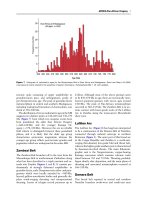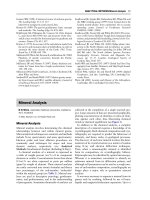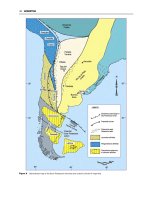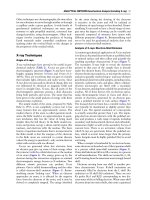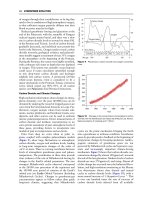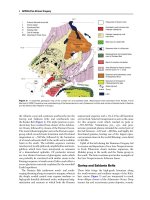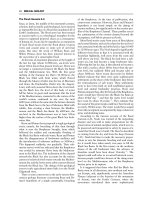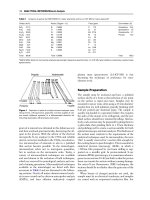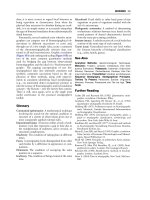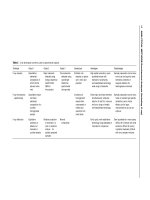Encyclopedia of geology, five volume set, volume 1 5 (encyclopedia of geology series) ( PDFDrive ) 3091
Bạn đang xem bản rút gọn của tài liệu. Xem và tải ngay bản đầy đủ của tài liệu tại đây (125.24 KB, 1 trang )
554 UNIDIRECTIONAL AQUEOUS FLOW
Figure 11 Velocity profiles measured over a dune bedform, showing flow separation in the dune leeside and boundary layer
recovery over the stoss side of the next downstream dune. Flow left to right. Reproduced from Nelson JM, McLean SR, and Wolfe SR
(1993) Mean flow and turbulence fields over two dimensional bedforms. Water Resources Research 29: 3935 3953, with permission from
American Geophysical Union.
Other Factors Influencing Boundary
Layer Structure
In many unidirectional aqueous flows, the precise
nature of the mean and turbulent flow is influenced
by a range of variables that can significantly alter the
flow structure, bed shear stress, patterns of sediment
transport, and, hence, development of bed morphology. Some of the most significant influences on the
characteristics of unidirectional aqueous flows are
described below.
The Nature of Bed Grain Roughness
Particle roughness significantly increases the potential for turbulent mixing near the bed and often
results in an increase in the gradient of the near-bed
velocity profile, with a concomitant increase in the
bed shear stresses derived from the velocity gradient,
Reynolds stress, or turbulent kinetic energy budget.
Grain roughness may destroy the viscous sublayer and
also increase the generation of turbulence near the
bed, through either encouraging intensified bursting
(quadrant 2 events) from between the grains (and thus
larger-scale return quadrant 4 events) or generating
regions of flow separation around individual grains
or groups of particles, which may both create significant velocity gradients near the bed and generate
large-scale coherent vortices, associated with flow
separation both in front of and behind the particles,
which can penetrate the entire flow depth (Figure 10).
The Presence and Type of Bedforms
Many bedforms such as ripples, dunes and largerscale bar forms, create their own flow field through
topographic, convective accelerations and decelerations of fluid that may significantly change the
Figure 12 Schematic diagram of the attenuation or enhance
ment of turbulence due to the presence of sediment in a flow as a
function of the volumetric sediment concentration, C, and the
ratio of the particle response time to the turbulence time scale,
tp/te (after Elghobashi S (1994) On predicting particle laden
turbulent flows. Applied Scientific Research 52: 309 329).
nature of a unidirectional flow. In addition, many
bedforms are also associated with flow separation
on their upstream stoss side or downstream lee side,
which generates appreciable turbulence and a boundary layer that is recovering from flow separation
downstream of the region in which the flow
reattaches to the bed (Figure 11).
The Type and Quantity of Suspended Sediment
Many turbulent flows transport appreciable quantities of suspended sediment, with the suspended concentration in some flows reaching levels at which the
flows become markedly non-Newtonian, such as in
the Huanghe River in China, where concentrations
of up to 1290 kg m 3 have been recorded. Suspension
